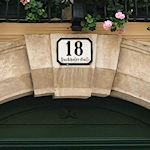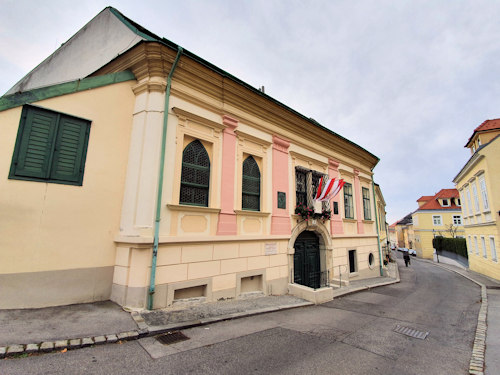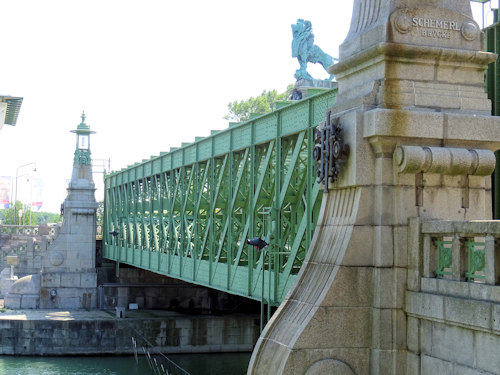
Vienna has plenty of residences with a musical connection. One house out near the Danube has two: Franz Lehár and Emanuel Schikaneder.
- Mini-palais dating back to the 1737
- Schikaneder’s residence in the early 1800s
- And Franz Lehár’s in the 1930s and 1940s
- Book a concert experience* for your Vienna trip
- See also:
Composers and impresarios

(A small villa in the suburbs)
Vienna has swallowed up many rural regions and settlements over the years. One is Nußdorf, still best known for its wine taverns and small town atmosphere.
In the past, Nußdorf would have made a convenient summer retreat for those Viennese wealthy enough to own a second home in the country or wishing to retire to somewhere quieter.
The Lehár-Schikaneder-Schlössel certainly served that function. The property has existed for centuries, but the current building dates back to 1737 (though it went through subsequent redesigns by later owners).
One of those owners was Emanuel Schikaneder, who lived in this Baroque mini-palais on and off in the early 1800s.
Life outside the city walls wasn’t always about sultry evenings and cool glasses of wine. Napoleon’s troops passed this way and allegedly plundered the residence in 1809.

(The front entrance with three commemorative plaques)
Schikaneder left a lasting impression on world culture through his association with Mozart. He wrote the libretto to The Magic Flute, for example, and played the role of Papageno himself. He also founded the Theater an der Wien, now one of Vienna’s three major opera houses.
The Schikaneder-Schlössel, as the house became known, eventually ended up in the hands of a Mr Widitz-Ward (?) from America, who sold it to the composer Franz Lehár toward the end of 1932 for the tidy sum of 120,000 Schilling.
And so the Schikaneder-Schlössel became the Lehár-Schlössel. After Lehár’s death, the property passed to his brother, Anton.
Stand outside the building today and three commemorative plaques mark the historical associations.

(The Lehár plaque)
- Anton Lehár himself erected the plaque to his brother. It bears an inscription I struggle to translate, but seems to indicate how Lehár’s mastery of music lets us forget our sorrows
- A later addition was a plaque commemorating Schikaneder
- The most recent plaque honours the singer and actor, Richard Tauber, a close friend of Franz Lehár. He married the English actress Diana Napier in 1936 in London, though the church ceremony apparently took place in the chapel of the Lehár-Schlössel
How to get to the Schlössel
The house practically counts as a riverside location, since the mighty Danube is just over 100m away.

(Otto Wagner’s Schemerlbrücke bridge)
This is where the Donaukanal channel breaks off from the main river and wends its way to the edge of the old town before rejoining the Danube on the other side of the city.
You’re just a short walk from the Schemerlbrücke, for example: Otto Wagner, one of the fathers of modern architecture, designed this bridge and weir.
The area enjoys other musical connections. For example, house no.8 on the same road carries a plaque commemorating the composer Carl Millöcker. His father was born there, apparently.
Head south from the Lehár-Schlössel and you find yourself in Grinzing, which enjoys fame for its wine taverns and Beethoven locations. The Beethoven Museum, for example, is a 20 minute walk away.
Subway: take the U4 line to Heiligenstadt and walk up or cross through Karl-Marx-Hof to Heiligenstädter Straße and catch the D tram to Nußdorf.
Tram/bus: take the D tram (which leaves from, for example, Schottentor in the centre) to the Nußdorf stop.
Address: Hackhofergasse 18, 1190 Vienna